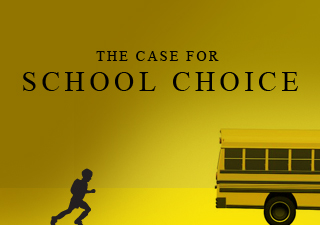Commentary

School Daze Ends with Choice
If Pennsylvania’s public schools are broken, why don’t we just fix them? Easier said than done, of course, but it’s not from a lack of trying. For decades, taxpayers, parents and politicians have surrendered to the pleas of the unions and school boards that they would deliver improved academic performance if given more time and money.
Despite Pennsylvania taxpayers spending $26 billion annually on public schools and more per student than 39 other states ($13,000 per child); and despite a decreasing student enrollment of nearly 27,000 student while adding nearly 33,000 employees since 2000, Pennsylvania public schools failed to deliver anything other than stagnating returns on that investment.
In fact, notwithstanding dramatic increases in spending and adding more personnel to “help students,” Pennsylvania’s performance on the National Assessment of Education Progress exam has remained relatively unchanged for years. Moreover, for all of its investment in the current system, Pennsylvania can show only about half of its 11th graders score at or above proficiency on the Pennsylvania System of School Assessment reading and math exams, and ranks among the worst performing states in SAT college entrance exams.
Why have we failed? To answer that question, it is useful to take a step backward and examine the nature of the various reforms that have been tried. All reforms designed to improve the quality of education fall into three categories: Those dealing with rules, those involving resources, and those concerned with incentives.
Rules-based reforms include such things as extending school days and the school year, changing teacher certification and school accreditation requirements, imposing national and state testing, enacting stricter dress codes, and the like. Research has shown that these reforms, while causing marginal improvements, have failed to reverse a large-scale decline in education. While additional rules are a politically expedient and popular means of addressing a problem, they have little or no correlation with improved academic achievement.
Another popular means of attempting to improve public education is through resource-based reforms. They include such measures as increased funding, new textbooks, wiring schools for Internet access, renovating or updating school facilities, reducing class sizes (more teachers per pupil) and other measures that require greater financial resources.
But if more rules and more resources equal better education, we certainly have not seen the results in Pennsylvania.
The third category of educational change is incentive-based reform. This new dynamic compels schools to either improve or risk going out of business. In a limited manner, incentive-based reforms include public school choice through charter schools and public “schools-of-choice” programs, while more expansive programs include choice among private schools, as well as public schools, through vouchers or tax credit-funded scholarships.
Advocates of such reforms suggest that just as consumers improve the products they purchase by exercising their judgment of value in choosing one product over another, parents will be able to improve education by applying their own values and priorities in selecting a school. In this way, schools will be supplied with a needed market incentive that would drive continuous quality improvement.
Senators Jeff Piccola (R) and Tony Williams (D) recently introduced legislation (Senate Bill 1) that would dramatically expand school choice options of low- and middle-income families through tax-funded vouchers and tax credit-funded scholarships—paid for with the $26 billion Pennsylvanians already spend on K-12 education.
Proponents of these types of incentive-based reforms argue that just as businesses respond to heightened levels of competition by making better products, schools will respond to competition by delivering higher-quality education. They believe that assigning children to schools based on where they live is like a business monopoly situation, in which consumers in a particular geographical area can buy a product from only one source. The business/school has no incentive to deliver a quality product because no competitor is pushing it to do so.
Instead of repeating the failed attempts to reform education through new rules or additional resources, these reforms use a market-oriented incentive—competition—to encourage traditional public schools to improve.
By ending the stranglehold of status quo defenders and special interests that financially benefit from the government monopoly of public education, school choice gives hope to Pennsylvania parents and students who may someday soon become the valued customers their tax dollars and efforts deserve.
# # #
Matthew J. Brouillette is president and CEO of the Commonwealth Foundation (www.CommonwealthFoundation.org), an independent, nonprofit public policy research and educational institute based in Harrisburg.